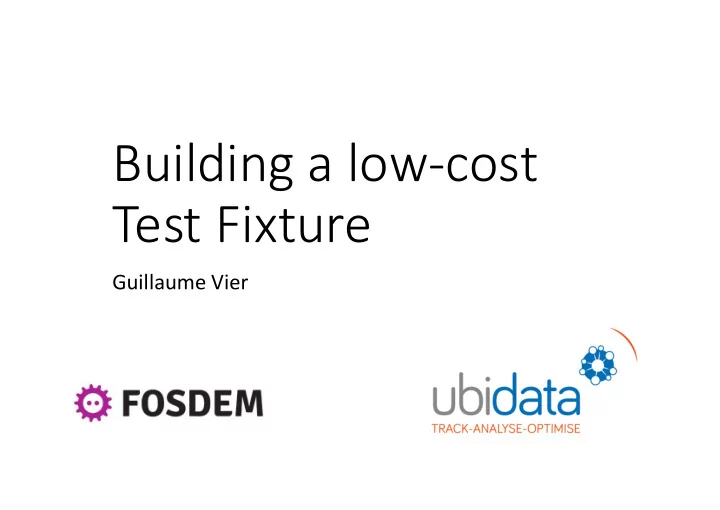

Building a low-cost Test Fixture Guillaume Vier
Agenda • Background • Motivations • Architecture • Bed of nails • Test Controller • Flasher • Conclusions 2
Background • Ubidata founded in 2003 in Brussels • Telematics and mobile logistics solutions • We design and build our own battery-powered tracking device 3
Motivations • Functional testing at the end of the assembly line • Run self-test on each PCB • Program production firmware • Small form factor: • PCB: 67 mm x 36 mm • Test points: ø 0.6 mm, spacing 1.27 mm 4
Motivations Standard test fixture (€€€) Can we build something cheaper with off-the-shelf components? 5
Architecture • Bed of nails: custom PCB + soldered test probes • Test controller: Raspberry Pi Zero • Flasher: OpenOCD 6
Bed of nails Custom PCB to: • align the Device Under Test over the probes • connect test points to larger header PCB designed with KiCad 7
Bed of nails Step 1: schematics • wire test probes to a larger connector 8
Bed of nails Step 2: create custom footprint for probe Constraints: • manufacturer’s capability: • pad to pad spacing • annular ring size • Test points spacing • Probe diameter Pad size: 1.1 mm x 2 mm, ø 0.75 mm 9
Bed of nails Step 3: PCB layout • DUT’s edges drawn on silkscreen layer • Test points’ coordinates extracted from DUT’s gerber files • Set origin point for the grid on new layout • Place footprints with: • Position Relative To… -> Use Grid Origin 10
Bed of nails 11
Bed of nails 12
Bed of nails 13
Test Controller • Raspberry Pi Zero running TinyCore • Minimal Linux system • Runs from RAM • Test scripts written in Python • Communicate with DUT via UART 14
Test Controller Pimoroni Automation pHAT: • 1 relay -> Supply power to DUT • 3 ADCs -> Measure voltage rails 15
Flasher • Connect to microcontroller via SWD • OpenOCD compiled with GPIO bitbang support ./configure --enable-sysfsgpio --enable-bcm2835gpio • Running on the Pi Zero • Define pins for SWD in script 16
Conclusions Cost comparison Standard Low-cost Bed of nails 3000 € - 6000 € 2 PCBs: 24 € 13 probes: 18 € Others: 20 € Test controller 100 € RPi Zero + pHAT: 25 € Flasher 2 x 300 € 0 € Total 3700 € - 6700 € 87 € 17
Conclusions • Cheap • Robust • Easy to build/replicate Limitations: not suited if special probes required (e.g. RF probes) 18
Assembly 19
References • Test probes P50 series: https://be.farnell.com/fr-BE/multicomp/p50-e-120-g/levier-large-point/dp/1568259 • Automation pHAT from Pimoroni: https://shop.pimoroni.com/products/automation-phat 20
Recommend
More recommend